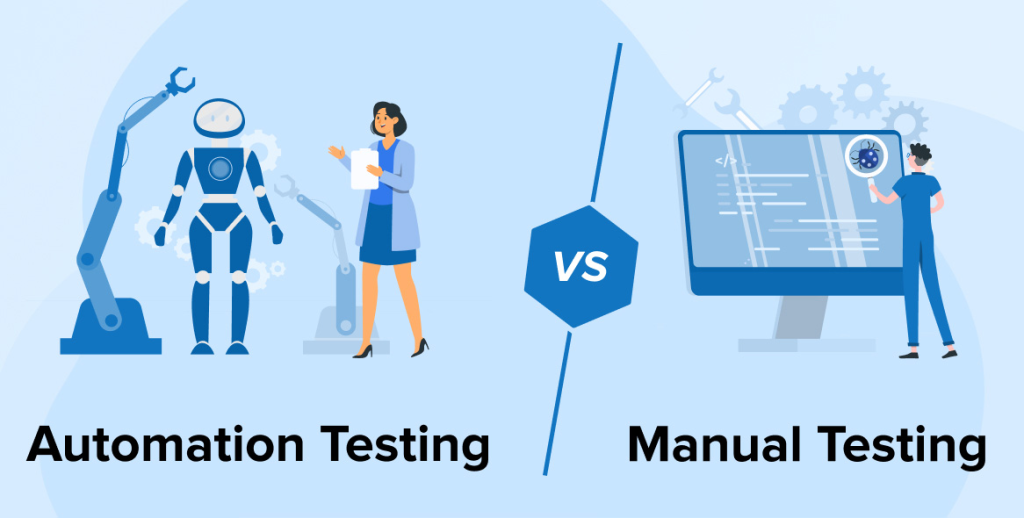
In the domain of software development and quality assurance, testing holds a pivotal role in guaranteeing the reliability and functionality of applications. Two key methodologies, namely manual testing and automation testing, fulfill distinct roles in this process. This blog post aims to delve into the fundamental distinctions between manual testing and automation testing, offering insights into their respective advantages and limitations.
Human Judgment and User Experience:
Manual Testing: Permits human judgment in the evaluation of subjective aspects like user experience, design, and aesthetics. Testers have the opportunity to offer valuable feedback extending beyond simple pass/fail results.
Automation Testing: Centers around objective pass/fail criteria, allowing for efficient validation of functional aspects. However, it may overlook nuanced aspects of user experience that human testers excel in assessing.
Human Interaction vs. Scripted Execution:
Manual Testing: In manual testing, human testers engage with the software by exploring its features and evaluating its functionality. This process involves simulating real-user scenarios to identify issues and defects.
Automation Testing: Utilizes scripts or code to automate the execution of test cases. Test scripts are formulated to execute predefined actions, enabling repetitive and systematic testing.
Adaptability to UI Changes:
Manual Testing: Easily adapts to changes in the user interface (UI) as testers can navigate and interact with the updated UI seamlessly.
Automation Testing: Might necessitate adjustments to scripts in the event of UI changes, presenting potential challenges in terms of maintenance.
Cost Considerations:
Manual Testing:
Initial setup costs are minimal as it doesn’t demand specialized tools or extensive scripting knowledge. Nevertheless, long-term costs may escalate with growing testing demands.
Automation Testing: Involves higher initial costs attributed to tool investment and script development. However, over time, automation has the potential to yield cost savings, particularly in the context of regression testing and large-scale projects.
Execution Speed and Efficiency:
Manual Testing: Tends to be time-consuming, particularly for repetitive test cases. The human element introduces variability in execution time and may impose limitations on the scalability of testing efforts.
Automation Testing: Provides expedited execution of repetitive test cases, enhancing overall efficiency. Automated tests can operate continuously, 24/7, providing swift feedback on the software’s stability.
Flexibility and Adaptability:
Manual Testing:Provides flexibility in adapting to changes in the software. Testers can readily modify test cases, explore new scenarios, and intuitively identify unexpected issues.
Automation Testing: Demonstrates less flexibility in the presence of swiftly changing requirements. Test scripts may necessitate frequent updates, posing challenges in keeping pace with agile development cycles.
Exploratory Testing:
Manual Testing: Excels in exploratory testing, wherein testers actively explore the software and adapt their approach based on their findings. This is crucial for uncovering unforeseen issues.
Automation Testing: Lacks the human intuition essential for exploratory testing. Automated scripts adhere to predefined paths and might overlook subtle issues that a human tester could identify.
Conclusion
Both manual testing and automation testing form integral components of a well-rounded testing strategy. The choice between them, or a combination of both, hinges on factors such as project requirements, budget constraints, timeline considerations, and the nature of the software under development. Manual testing brings a human touch, adaptability, and a thorough exploration of user experience, whereas automation testing provides efficiency, repeatability, and scalability.
Ultimately, the harmony between manual and automation testing often serves as the linchpin of a successful testing strategy. Through a strategic amalgamation of the strengths inherent in both methodologies, development teams can secure comprehensive test coverage, expedite release cycles, and deliver high-quality software to end-users.
Digital Marketing Manager at Cotocus
